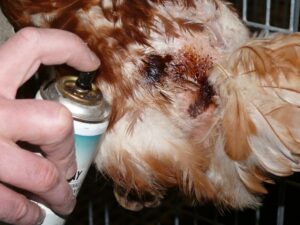Prevention
Injurious pecking can be prevented by ensuring:
- optimal design of the henhouse
- optimal furnishing of the range
- all measures that reduce fear and stress in the flock (both external as internal/genetic)
- all measures that improve bird health
Prevention of injurious pecking is always a matter of keeping the flock in balance. Depending on the housing system, the character of the flock, the farmer and the henhouse some measures will be more feasible than others. There is no standard formula for prevention of feather pecking. All factors mentioned under ‘Risk factors’ should be evaluated and optimized.
Measures
Reducing light intensity and/or switching to red light is a measure often taken when feather pecking occurs. Under red light, wounds do not contrast as much with brown feathers and thus attract less attention. This could help to reduce cannibalism. However, under dimmed lighting birds often become more fearful, which may counteract attempts to prevent feather pecking.
Whenever it is expected that birds are more likely to develop injurious pecking extra measures should be taken, e.g. providing extra roughage.
Treating affected birds
Affected birds can be treated with a violet spray to prevent further pecking of the affected area. They may also be kept in quarantine (separate pens) until the wounds have healed. Badly affected birds should be culled to prevent further suffering.

Mortality
Mortality due to injurious pecking in furnished cages can be lower, on average, than in non-cage systems. Figures from the UK indicate that it is around 5.0 – 8.7% (or 65% of total mortality). In non-cage systems there is much more variation and the total mortality can increase up to 20-30%, of which 6-26% can be due to cannibalism, although the average figure is much lower.
.
Beak trimming
Beak trimming is used to prevent the very worst effects of injurious pecking (i.e. cannibalism) but it does not tackle the underlying causes of injurious pecking, nor does it fully eliminate the risk of feather pecking. Beak trimming is a mutilation, amputating the sensitive tip of the beak of the birds. Beak trimming therefore is painful to the birds, even if it is done at young age with an Infra Red beam. Ideally, from the point of view of animal welfare, the environment and management should be arranged to ensure and safeguard bird welfare. In fact, mutilations adapt birds to a suboptimal environment, which is not the preferred way to keep animals.
According to Council Regulation 834/2007 beak trimming is not allowed for organic production in Europe. Some countries have banned beak trimming for all production systems.
.
Economics
Injurious pecking is a serious problem both in commercial flocks with intact beaks and in those with trimmed beaks. In Switzerland about 1/3 of the farmers take measures to prevent feather pecking. In the UK, 47% of the farmers indicated that feather pecking is a normal occurrence, despite beak treatments. Researchers found that at least 65% of the flocks in the laying period have signs of severe feather pecking, despite beak treatments. This inevitably leads to a reduction in feather cover and increases (up to 40% or more) in feed intake. Increased feed costs and mortality result in serious economic losses due to feather pecking.
.
Further reading
SPECIFIC
Scientific
Nederlands
- Ingrepen bij pluimvee : update 2011 “Literatuurstudie ingrepen bij pluimvee” [Mutilations in poultry : update 2011 “Literature study mutilations poultry”]. Niekerk, T.G.C.M. van; Jong, I.C. de; Veldkamp, T. ; Krimpen, M.M. van , 2011. ASG Veehouderij/ Wageningen UR, 2011 (Rapport / Animal Sciences Group 468) – p. 75.
- Ingrepen bij pluimvee : update ‘Literatuurstudie ingrepen bij pluimvee, 2006’ [Mutilations in poultry : update literature study “Literature study mutilations poultry, 2006”]. Fiks, T.G.C.M. ; Jong, I.C. de; Veldkamp, T. ; Krimpen, M.M. van; Emous, R.A. van, 2009. ASG Veehouderij/ Wageningen UR, 2009 (Rapport / Animal Sciences Group 255) – p. 46
